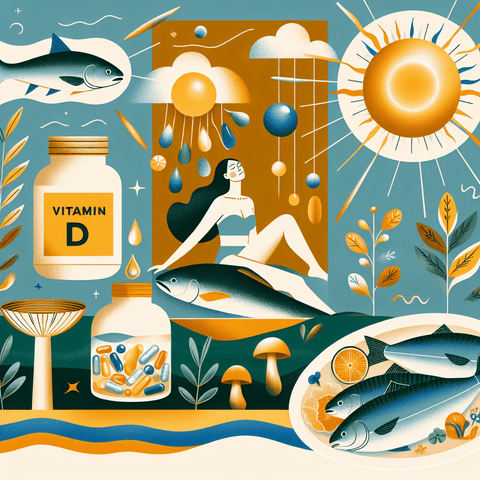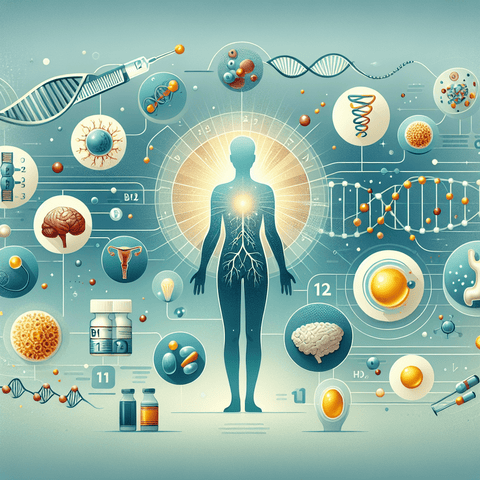Introduction
Vitamin D is an essential fat-soluble nutrient that plays a pivotal role in maintaining overall health and well-being. Known for its critical importance in calcium absorption, bone mineralization, and immune system regulation, vitamin D has garnered considerable attention over the years. As scientific research continues to unravel its multifaceted role in human physiology, the need to attain and maintain optimal levels of vitamin D becomes increasingly apparent. Unlike many vitamins that we obtain primarily through dietary sources, vitamin D is somewhat unique. The body can synthesize it with the help of sunlight, making it part nutrient, part hormone. Despite this, vitamin D deficiency continues to be a global health concern, especially in regions with low sunlight exposure or among populations with restricted dietary patterns. While vitamin D can be obtained through natural food sources, sun exposure, and fortified foods, the reality is that many individuals struggle to meet their daily requirements through these methods alone. In such cases, nutritional supplements provide a reliable, convenient solution. In this comprehensive guide, we will explore the main sources of vitamin D—from the sunshine outside your window to the food on your plate and the supplements in your cabinet. By understanding where vitamin D is most commonly found, you'll be better equipped to make informed decisions about your health.1. Vitamin D in Nutritional Supplements: A Convenient Way to Boost Your Levels
Vitamin D supplements have become a widely accepted and convenient method for ensuring sufficient intake of this essential nutrient. They are available in various forms, including tablets, capsules, softgels, chewables, and even liquids—catering to people across all age groups and dietary needs. There are two primary types of vitamin D supplements: D2 (ergocalciferol) and D3 (cholecalciferol). Vitamin D3 is generally considered more effective at raising and maintaining adequate levels in the bloodstream. It is what the skin naturally synthesizes from sun exposure and is often derived from animal sources like lanolin (from sheep’s wool) or fish oil. Vitamin D2, on the other hand, is plant-based and commonly used in fortified foods and vegan supplements. Why are vitamin D supplements so important? Quite simply, many people do not receive enough vitamin D through food or sun exposure alone. For instance, people living in higher latitudes or urban areas may receive limited sunlight, and strict vegans or those with food allergies might not consume sufficient dietary vitamin D. Specific populations benefit significantly from supplementation. Older adults often experience reduced skin elasticity, which lowers their natural vitamin D production. People with darker skin, due to higher melanin levels, also have a reduced capacity to synthesize vitamin D from sunlight. Additionally, individuals with conditions affecting fat absorption—such as Crohn's disease or celiac disease—may not effectively absorb fat-soluble vitamins like D. Supplementation offers a clinically backed, safe, and effective way to redress these imbalances, especially when guided by healthcare professionals. Consumers interested in exploring trusted vitamin D options can browse curated collections, such as Topvitamine’s Vitamin D category, for products formulated to support overall wellness. Ultimately, while food and sunlight sources of vitamin D are invaluable, supplementation ensures reliability and consistency—making it one of the most common and accessible ways to maintain sufficient levels.2. Sun Exposure and Vitamin D: The Natural Way to Obtain Your Daily Dose
One of the most remarkable aspects of vitamin D is the body’s ability to produce it naturally when the skin is exposed to sunlight, specifically ultraviolet B (UVB) rays. This endogenous synthesis process converts 7-dehydrocholesterol in the skin into previtamin D3, which is then transformed into active vitamin D (calcitriol) through metabolic pathways in the liver and kidneys. For many, sun exposure is the most straightforward method of acquiring vitamin D. It’s entirely free and, if practiced wisely, offers more than just vitamin D—boosting mood and circadian regulation as well. However, the efficiency of this process depends on several key factors. Duration and timing are crucial. The ideal window is typically between 10 AM and 3 PM, when UVB rays are most intense. Roughly 15 to 30 minutes of direct sun exposure on uncovered skin, such as the arms and face, can initiate adequate vitamin D synthesis in many individuals. However, wearing sunscreen—while important for skin protection—can significantly diminish this synthesis. A balance must be struck between safe sun exposure and overexposure risks. Individual traits also influence sunlight-derived vitamin D production. People with darker skin tones have more melanin, which acts as a natural UV filter, requiring longer sun exposure to produce the same amount of vitamin D as someone with fair skin. Age also plays a role; elderly individuals synthesize vitamin D less efficiently due to thinner skin. Geographic location, season, and pollution levels are further determinants. People living in northern latitudes or areas with high air pollution may get inadequate UVB year-round, making synthesis difficult. Moreover, during winter months, the sun’s angle may prevent effective UVB from reaching the skin. Although natural and effective, relying solely on sun exposure poses challenges. Overexposure can increase the risk of skin cancer and premature aging, necessitating a mindful approach. In such cases, integrating supplementation and dietary strategies becomes vital. Combining moderate, safe sun exposure with other vitamin D sources offers a balanced approach, supporting not only skeletal health but also broader physiological functions. If sunlight access is limited or unreliable, consider evaluating dietary intake or looking into high-quality sources available on platforms like Topvitamine to keep your levels optimal.3. Dietary Sources of Vitamin D: Foods That Pack a Nutritional Punch
Though fewer foods naturally contain vitamin D compared to other essential vitamins, certain animal-based and plant-based options still contribute meaningfully to your daily intake. Let’s explore the top whole foods where vitamin D is most prevalent. Fatty fish top the list. Salmon—especially wild-caught varieties—offers one of the richest natural sources of vitamin D, delivering up to 988 IU (International Units) per 100-gram serving. Mackerel and sardines follow closely, valued not just for their vitamin D content but also their omega-3 fatty acids, which support cardiovascular and brain health. Canned tuna is a convenient alternative, providing roughly 268 IU per 100 grams. Other nutrient-dense animal-based foods include liver, particularly beef liver, and egg yolks. While liver is highly nutritious, it should be consumed in moderation due to its high vitamin A content. Eggs, especially from hens raised outdoors or fed vitamin D-enriched feed, contribute modest amounts of the vitamin, making them a useful addition to a balanced diet. For vegetarians and vegans, the options are more limited. Mushrooms exposed to sunlight or ultraviolet light—particularly varieties like maitake and shiitake—contain vitamin D2, the plant-based form of the vitamin. While less effective than vitamin D3, it still contributes positively to overall levels. Nevertheless, obtaining the recommended daily intake (around 600–800 IU for most adults) solely from food can be challenging. For instance, you'd need to consume roughly 3 ounces of cooked salmon or 10 eggs just to meet the lower threshold of daily needs. This might not be sustainable—or palatable—for everyone. The nutrient-deficient nature of many modern diets adds another layer of complexity. People consuming mostly processed or plant-based diets may face hurdles in securing adequate vitamin D without fortification or supplementation. For those committed to eating clean and covering all essential bases, integrating omega-3 supplements—like those found in Topvitamine’s DHA & EPA omega-3 collection—can be a helpful strategy. Some fish oil supplements also provide measurable vitamin D per serving. In summary, while whole foods should form the baseline of any nutritional strategy, their limitations require thoughtful integration with other sources, particularly for those with restrictive diets or health conditions.4. Fortified Foods: Making Vitamin D Accessible to All
To combat widespread deficiency and support public health, governments and food manufacturers have implemented fortification programs, enhancing commonly consumed foods with essential nutrients like vitamin D. This proactive approach addresses dietary insufficiencies through everyday eating patterns, making nutrition more inclusive and attainable. Fortified foods are artificially enriched with vitamins and minerals not originally present or found in minimal amounts in the original form. With vitamin D, fortification has proven particularly effective, especially in countries with limited sunlight exposure or populations with lower consumption of vitamin D-rich foods. One of the most common fortified items is cow’s milk. In many countries, a single cup of vitamin D-fortified milk provides around 100-130 IU—about 15%–20% of the daily RDI. Plant-based alternatives like soy milk, almond milk, and oat milk are also frequently fortified, making them suitable choices for vegans and lactose-intolerant individuals. Breakfast cereals offer another accessible avenue, with many popular brands adding between 40 and 100 IU per serving. Additionally, some orange juices, margarines, and yoghurts are also fortified to enhance nutritional value. These fortified options fit seamlessly into daily routines and cover a wide demographic range, from children to older adults. Despite these advancements, it's important to recognize that not all fortified foods offer the same bioavailability or dosage. Checking nutrition labels for the type and amount of vitamin D added (D2 vs. D3) can help consumers make informed selections. The impact of fortification policies has been significant. Countries like Finland and Canada, which have long-standing mandatory fortification programs for dairy products, have seen improvements in average vitamin D levels among their populations. In regions without consistent policies, proactive consumers benefit from choosing fortified items as part of a broader strategy. Fortified foods play a crucial role in bridging nutritional gaps when sun exposure and diet fall short. Combined with high-quality supplements—such as those available at Topvitamine—fortification ensures broader community access to essential health resources.5. Sunlight Synthesis: The Body’s Internal Production of Vitamin D
Understanding the biological basis of how the body produces vitamin D can further clarify why multiple sources are needed to maintain sufficiency. Upon exposure to ultraviolet B (UVB) radiation, a form of cholesterol in the skin—7-dehydrocholesterol—is converted to previtamin D3. This molecule then undergoes thermal isomerization into vitamin D3 (cholecalciferol), which is subsequently activated in the liver and kidneys into calcitriol, the hormone’s active form. This highly efficient system is crucial to the process of internal vitamin D generation. However, several environmental and individual factors complicate its consistency. One major factor is geographic latitude. Individuals living above 37° latitude (e.g., much of North America, Northern Europe) experience weaker UVB exposure during winter months. As a result, skin synthesis of vitamin D becomes practically dormant for a significant part of the year. The season and time of day also influence production. During early morning and late afternoon, UVB rays cannot effectively penetrate the atmosphere. Winter sun, even at midday, may also fall short—particularly with heavy cloud cover or air pollution, the latter of which scatters UVB radiation. Air pollution creates a significant barrier. Ozone, particulate matter, and other pollutants absorb and block UVB radiation from reaching the ground. This is especially notable in densely populated or industrial areas. Even if UVB exposure is technically available, lifestyle choices affect uptake. Extensive use of sunscreen, staying indoors, or wearing covering clothing—albeit important for skin protection—markedly reduce the body’s ability to create vitamin D. Similarly, older age, obesity, and darker skin pigmentation contribute to decreased synthesis. To optimize sun-derived vitamin D without compromising skin health, moderation is key. Experts often recommend exposing arms, hands, and face without sunscreen for about 15 minutes, 2–3 times a week during midday hours—followed by sun protection. Utilizing sun responsibly, alongside dietary and supplemental options, remains an effective holistic strategy.6. Addressing Vitamin D Deficiency: Recognizing and Overcoming a Common Nutritional Issue
Vitamin D deficiency has become a global public health issue, affecting over one billion people worldwide. This condition is often termed a “silent epidemic” due to its mostly asymptomatic onset and grave long-term consequences if left untreated. Recognizing deficiency requires awareness of its common symptoms, which include fatigue, muscle weakness, bone pain, frequent infections, and mood disturbances (such as seasonal affective disorder). Chronic insufficiency can contribute to more severe conditions like osteoporosis, impaired immune function, and compromised muscle performance. Certain populations bear a higher risk of developing vitamin D deficiency. These include infants and elderly individuals, people with darker skin, those practicing strict veganism, individuals with fat-malabsorption disorders, and people who spend most of their time indoors. Women who are pregnant or lactating also face increased demands and risk. Combating deficiency involves a multi-pronged approach. Sunlight remains an effective, yet limited, source for many. Nutritional strategies emphasizing fatty fish, eggs, and fortified foods can supplement dietary needs, though they may not always suffice alone. This is where supplements become critical. Regular supplementation, especially in evidence-based dosages, has shown remarkable efficacy in correcting low levels. Regular screening—particularly for high-risk groups—is advisable to monitor serum 25(OH)D levels, which typically indicate vitamin D status. When aiming to bring levels back to a healthy range, it's important to select high-quality, reputable supplements. The curated selection of Topvitamine Vitamin D products offers options suitable for varied health goals and dietary needs. In cases where additional nutritional support is required, consider synergistic nutrients like magnesium or vitamin K2—both of which work in tandem with vitamin D. Helpful product assortments are found in Topvitamine’s magnesium supplements or vitamin K categories. Ultimately, awareness, proactive screening, and adopting a balancing act between diet, sun exposure, fortification, and supplementation can effectively combat vitamin D deficiency.Conclusion
Vitamin D is a unique and vital nutrient that can be acquired through a variety of sources, each with its own strengths and limitations. From sun exposure, natural foods, and fortified products to convenient nutritional supplements, maintaining optimal vitamin D levels requires a tailored, multifaceted approach. While sunlight is nature’s original source, real-world constraints often make it unreliable. Food sources provide valuable contributions, especially fatty fish and eggs, though they typically fall short of fulfilling daily requirements alone. Fortified foods represent a strategic way to meet broader public needs but must be consumed consistently. Supplements, then, stand out as an efficient, personalized solution—especially when designed to match individual health profiles and lifestyles. For most people, combining these sources strategically is key. Ensure you consult with a healthcare professional before initiating or modifying your vitamin D regimen, especially if you fall into a high-risk group or suspect a deficiency. Your journey to optimal wellness doesn’t have to be complex. By tapping into trusted sources such as the Topvitamine Vitamin D collection and integrating informed sun protection habits and diet strategies, you’re well on your way to supporting your long-term health.Q&A Section
Q: What is the most reliable source of vitamin D?
A: While sunlight is a highly effective natural source, supplements are considered the most reliable due to their consistency and dosage control, especially when dietary and environmental conditions are less favorable.
Q: Can I get enough vitamin D from food alone?
A: It is possible but difficult. Natural food sources contain limited amounts, and you would need to consume large quantities of fatty fish or fortified foods to meet daily needs. Supplementation is often necessary for sufficiency.
Q: How much sun exposure do I need for vitamin D?
A: Approximately 15–30 minutes of midday sun exposure to uncovered skin 2–3 times a week may provide enough for many individuals. However, this varies based on skin type, location, and season.
Q: What are the best vitamin D-rich foods?
A: Fatty fish (salmon, mackerel, sardines, tuna), egg yolks, liver, and UV-exposed mushrooms are among the top natural sources of vitamin D.
Q: Who should consider vitamin D supplements?
A: Individuals with limited sun exposure, darker skin, older adults, vegetarians/vegans, and those with specific health conditions related to fat absorption should consider supplements as part of their strategy.
Important Keywords
- Vitamin D sources
- Sun exposure for vitamin D
- Vitamin D supplements
- Foods with vitamin D
- Fortified foods vitamin D
- Vitamin D deficiency
- Natural sources of vitamin D
- Topvitamine vitamin D
- Omega-3 and vitamin D
- Vitamin D for health



